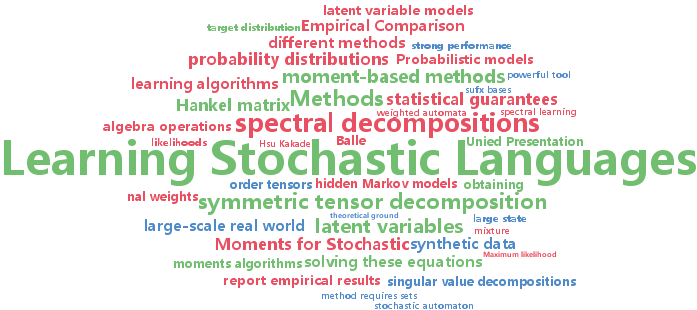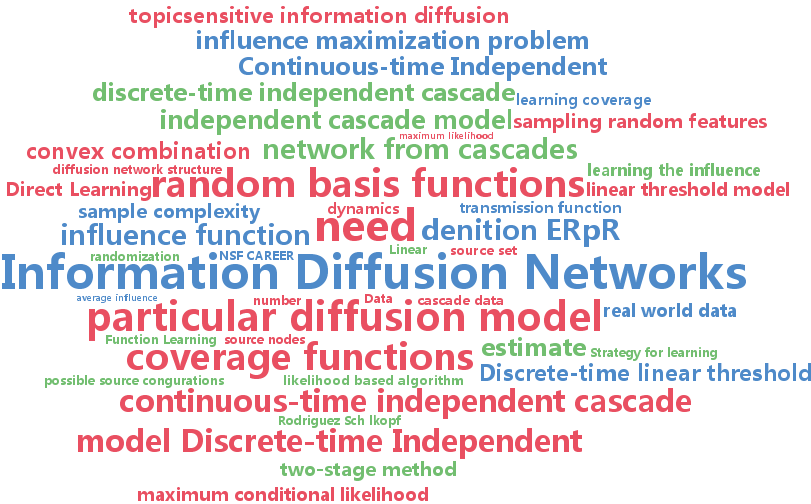maximum likelihood
-
Borja Balle and William Hamilton and Joelle Pineau
Methods of Moments for Learning Stochastic Languages: Unified Presentation and Empirical Comparison (pdf)
Probabilistic latent-variable models are a powerful tool for modelling structured data. However, traditional expectation-maximization methods of learning such models are both computationally expensive and prone to local-minima. In contrast to these traditional methods, recently developed learning algorithms based upon the method of moments are both computationally efficient and provide strong statistical guarantees. In this work, we provide a unified presentation and empirical comparison of three general moment-based methods in the context of modelling stochastic languages. By rephrasing these methods upon a common theoretical ground, introducing novel theoretical results where necessary, we provide a clear comparison, making explicit the statistical assumptions upon which each method relies. With this theoretical grounding, we then provide an in-depth empirical analysis of the methods on both real and synthetic data with the goal of elucidating performance trends and highlighting important implementation details.
-
Yoshua Bengio and Eric Laufer and Guillaume Alain and Jason Yosinski
Deep Generative Stochastic Networks Trainable by Backprop (pdf)
We introduce a novel training principle for probabilistic models that is an alternative to maximum likelihood. The proposed Generative Stochastic Networks (GSN) framework is based on learning the transition operator of a Markov chain whose stationary distribution estimates the data distribution. Because the transition distribution is a conditional distribution generally involving a small move, it has fewer dominant modes, being unimodal in the limit of small moves. Thus, it is easier to learn, more like learning to perform supervised function approximation, with gradients that can be obtained by backprop. The theorems provided here generalize recent work on the probabilistic interpretation of denoising autoencoders and provide an interesting justification for dependency networks and generalized pseudolikelihood (along with defining an appropriate joint distribution and sampling mechanism, even when the conditionals are not consistent). GSNs can be used with missing inputs and can be used to sample subsets of variables given the rest. Successful experiments are conducted, validating these theoretical results, on two image datasets and with a particular architecture that mimics the Deep Boltzmann Machine Gibbs sampler but allows training to proceed with backprop, without the need for layerwise pretraining.
-
Yariv Mizrahi and Misha Denil and Nando De Freitas
Linear and Parallel Learning of Markov Random Fields (pdf)
We introduce a new embarrassingly parallel parameter learning algorithm for Markov random fields which is efficient for a large class of practical models. Our algorithm parallelizes naturally over cliques and, for graphs of bounded degree, its complexity is linear in the number of cliques. Unlike its competitors, our algorithm is fully parallel and for log-linear models it is also data efficient, requiring only the local sufficient statistics of the data to estimate parameters.
-
Nan Du and Yingyu Liang and Maria Balcan and Le Song
Influence Function Learning in Information Diffusion Networks (pdf)
Can we learn the influence of a set of people in a social network from cascades of information diffusion? This question is often addressed by a two-stage approach: first learn a diffusion model, and then calculate the influence based on the learned model. Thus, the success of this approach relies heavily on the correctness of the diffusion model which is hard to verify for real world data. In this paper, we exploit the insight that the influence functions in many diffusion models are coverage functions, and propose a novel parameterization of such functions using a convex combination of random basis functions. Moreover, we propose an efficient maximum likelihood based algorithm to learn such functions directly from cascade data, and hence bypass the need to specify a particular diffusion model in advance. We provide both theoretical and empirical analysis for our approach, showing that the proposed approach can provably learn the influence function with low sample complexity, be robust to the unknown diffusion models, and significantly outperform existing approaches in both synthetic and real world data.
-
Zhaoshi Meng and Brian Eriksson and Al Hero
Learning Latent Variable Gaussian Graphical Models (pdf)
Gaussian graphical models (GGM) have been widely used in many high-dimensional applications ranging from biological and financial data to recommender systems. Sparsity in GGM plays a central role both statistically and computationally. Unfortunately, real-world data often does not fit well to sparse graphical models. In this paper, we focus on a family of latent variable Gaussian graphical models (LVGGM), where the model is conditionally sparse given latent variables, but marginally non-sparse. In LVGGM, the inverse covariance matrix has a low-rank plus sparse structure, and can be learned in a regularized maximum likelihood framework. We derive novel parameter estimation error bounds for LVGGM under mild conditions in the high-dimensional setting. These results complement the existing theory on the structural learning, and open up new possibilities of using LVGGM for statistical inference.




